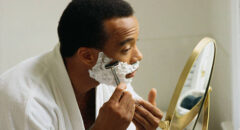 Does healthy foundation for a flawless look even exist? One of the most common problems that women make is putting too much of the wrong foundation all over their face, instead of choosing the right shade and formula for their skin, and then using less of it.
Does healthy foundation for a flawless look even exist? One of the most common problems that women make is putting too much of the wrong foundation all over their face, instead of choosing the right shade and formula for their skin, and then using less of it.
But first -- which form do you choose? There are sticks, liquids, creams, and powders.
Even skin, your skin isn't too dry or too oily, then for the most part you're fine with anything. Just be sure watch the timing of how long you keep your foundation on and that you're not allergic to any of the ingredients.
Dry skin is best with a cream or liquid -- these glide easily over the skin.
Oily skin is best with an oil-free liquid but a powder foundation's even better.
You should go for the sheerest coverage possible. Show your real skin through your foundation. It has life in it -- freckles and little idiosyncrasies are what make you...you. Liquid is the sheerest form of foundation. Powder and dual finish powder are less sheer. And cream can be the heaviest, most opaque of all.
How to get flawless skin
Foundation is the best way to make skin look smooth and even. It is general consensus that yellow-toned foundation looks the most natural on all skin tones. To find your perfect match, swatch a few shades on the side of your face and check your reflection in natural light. The shade that disappears is the right one. If you have to apply foundation on your neck to make it match your face, you're using the wrong shade. It's a good idea to have two shades of foundation — one for the winter months and a slightly darker one for the summer when skin color tends to warm up.
Foundation formulas range from low-maintenance tinted moisturizers to moisturizing liquid cream foundations with more coverage. Here's a look at what the different formulas have to offer:
- Tinted moisturizers and tinted balms combine the benefits of a face cream with the skin-evening properties of a foundation. They're a good choice for...
... normal and normal to dry skin that needs minimal coverage. - Liquid and cream foundations are available in both moisturizing and oil-free formulas. They are easy to blend and can go from medium to full-coverage depending on how much you apply. If you go for liquid, be sure to shake the bottle first to make sure heavier parts haven't settled to the bottom.
- Stick foundation is one of my favorite formulas because it's portable and quick and easy to apply. A good choice for normal skin, this travel-friendly formula won't ever spill and it can also be used to cover blemishes and scars.
- Compact foundation, with its cream to powder formulation, is best for oily skin. To avoid looking cakey, look for one that's not too powdery. Many compacts come with different sponges that allow you to control the amount of coverage you get.
Use your fingers or a makeup sponge to spot-apply foundation where skin needs to be evened out, especially around the nose and mouth where there's redness. For full, all-over coverage, use a foundation brush to apply and blend foundation. To give foundation staying power and take away shine, finish off with a dusting of powder.
As for powder, pale yellow-toned powder is the most flattering on all skin tones. A big beauty myth is that translucent powder is invisible. But it actually makes skin look pasty and ashy. The same holds for purple, pink or green powders designed to “correct” color — they don't look natural, so stay away from them. Look for a powder with a silky, lighter-than-air texture. Use loose powder at home and pressed powder when you travel, since it's more portable. Use a velour puff to apply the powder and dust off any excess with a powder brush. Apply a fair amount of powder if skin is oily. Dust it just around the nose and forehead if skin is dry. If you want a full face application, go for it. But the idea is to use foundation to perfect the skin, not hide it.








